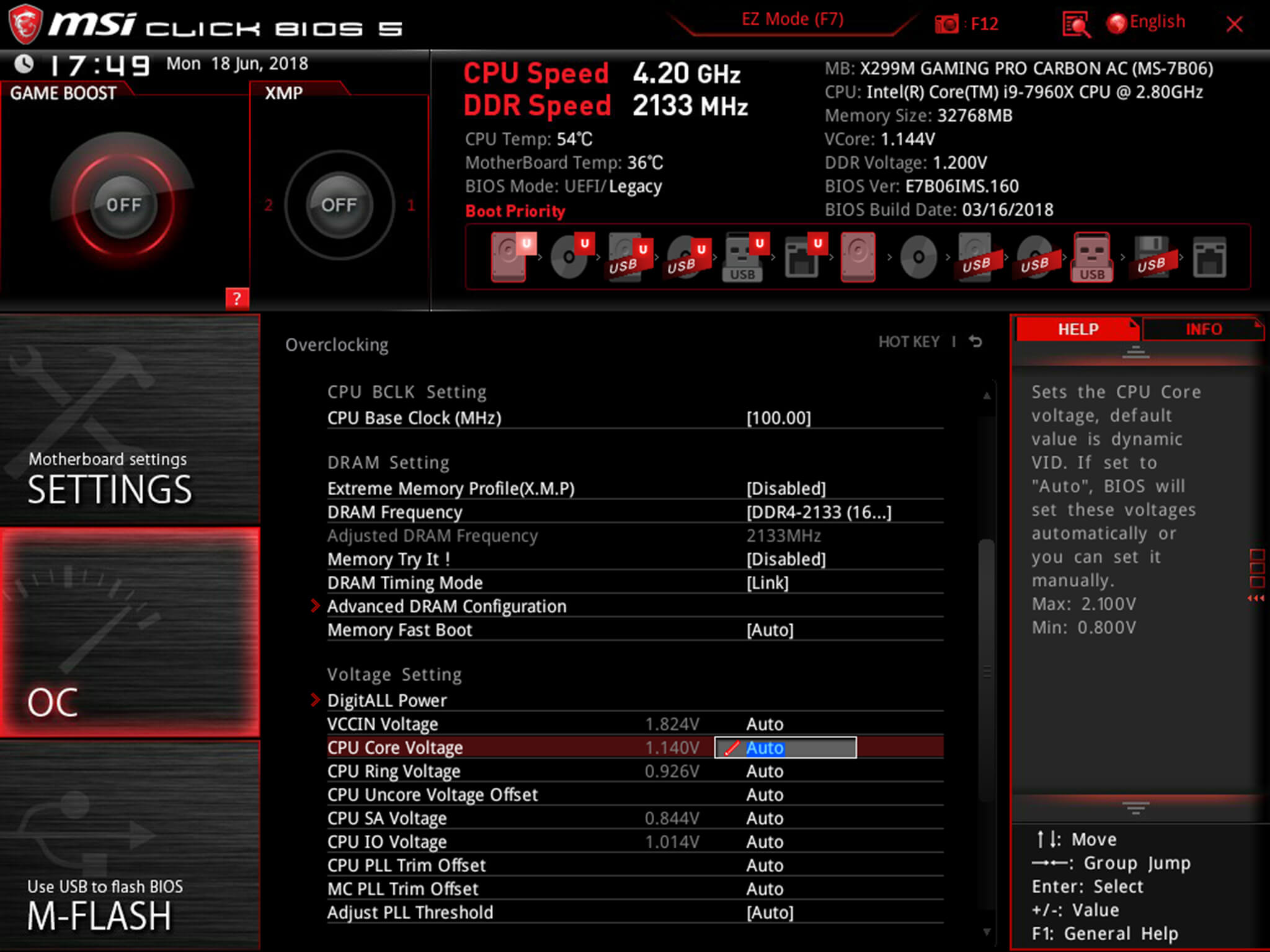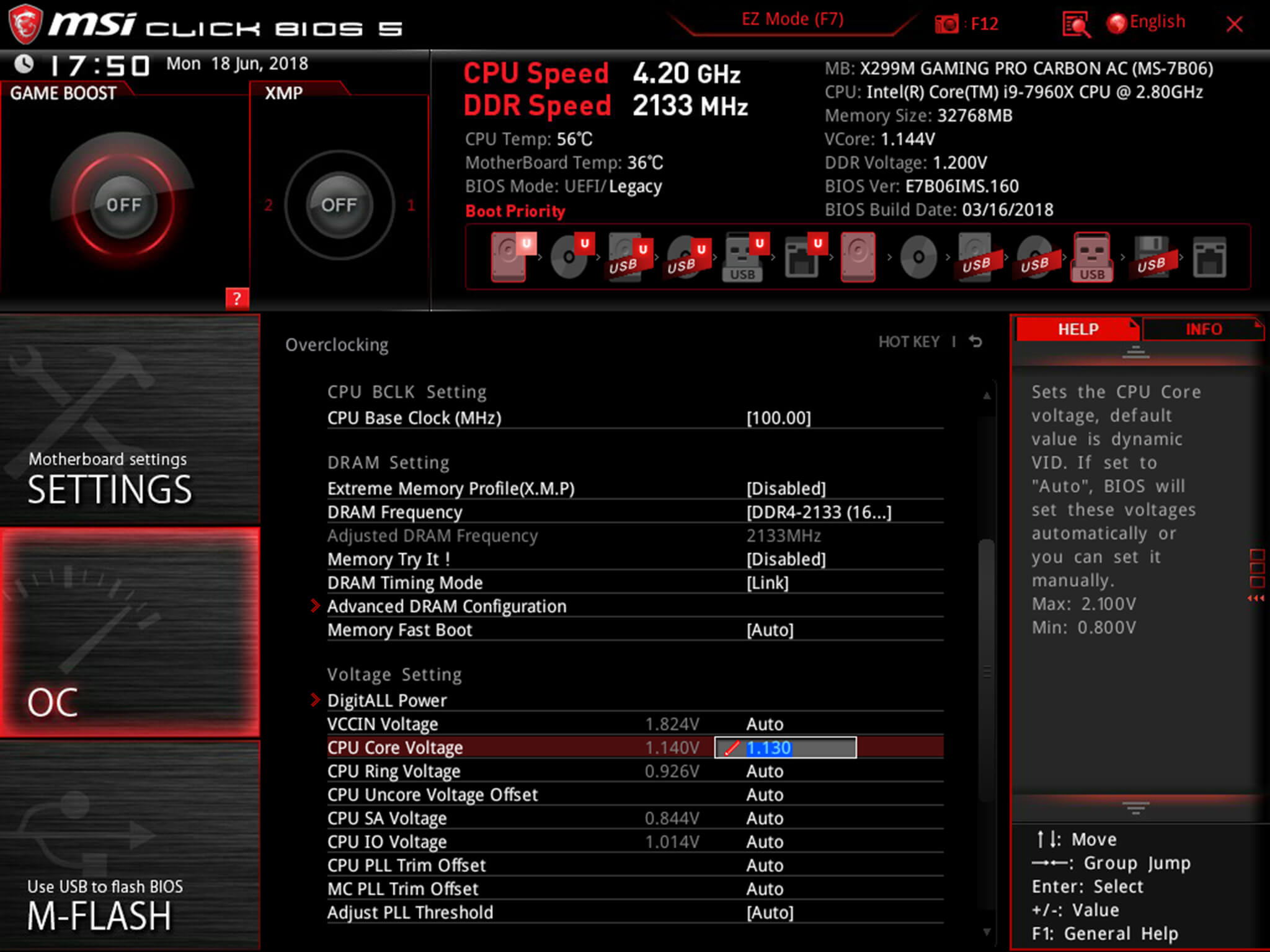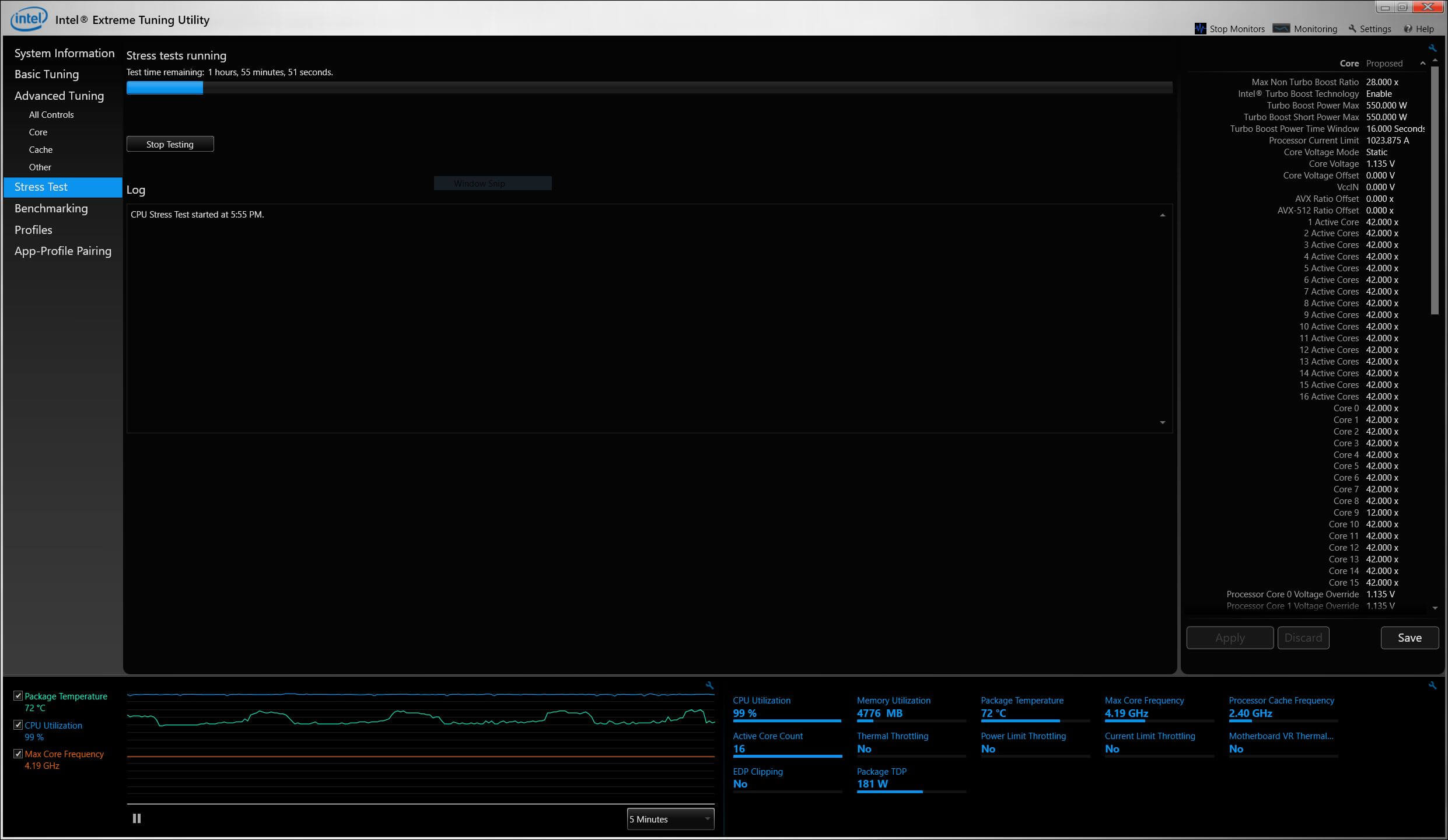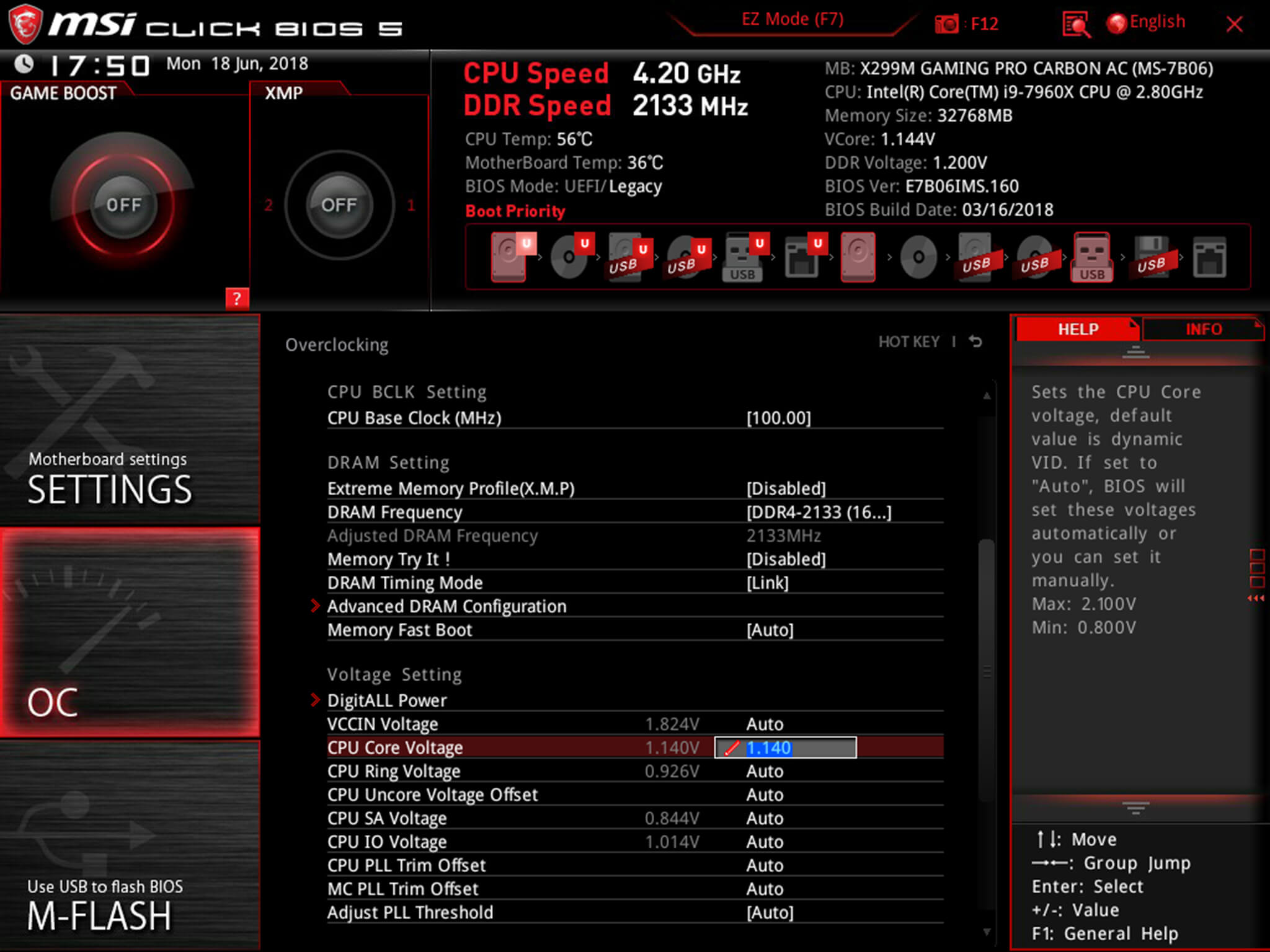The core voltage is different for each processor model, and while all CPUs of the same model have the same VID, not all samples maintain stability at the same clock speeds and Vcore due to slight variations in silicon quality. Every sample of the same CPU model is tested to maintain stability at the default speeds and the VID determined by the manufacturer.
Core voltage typically maintains a constant value while your CPU is in use; however, sometimes under heavy workloads vcore can fluctuate. This is known as Vdroop and can be corrected with load-line calibration. This applies additional voltage as load increases to maintain your CPU's stability.
When it comes to overclocking, you can only push your CPU's frequency so far before your CPU starts to experience instability. Programs might begin to crash or hang up, game performance could suffer or your computer could even fail to boot. This is because your processor isn't getting enough voltage to maintain system stability.
Increasing voltage will allow you to dial in the perfect overclock.
To adjust the voltage, you'll need to boot into your motherboard's BIOS and make adjustments there. The Vcore is expressed as a three decimal value, such as 1.235v. By default, the voltage control is set to auto; this can be overridden by typing in any value. Make sure not to exceed the recommended maximum for your processor.

Before fine-tuning the Vcore, it's important to find a good baseline value for a given speed. This varies from model to model but it can be helpful to read reviews for your CPU, specifically ones that focus on overclocking.
Most publications will list the voltage they required to keep several different speeds stable. Every CPU sample is different and you will need to fine-tune the voltage before calling it done; however, these values do provide a good starting point.

If you boot your machine and don't find any stability issues, then you know it's time to start decreasing the voltage. When overclocking, you want to find the lowest voltage required to maintain stability. More voltage equals more heat and this will allow you to keep temperatures under control.

The safest way to adjust voltage is with increments of .01 volts. Decrease voltage until your computer starts showing signs of instability under load. Use a program like Intel's Extreme Tuning Utility (XTU) or Prime95 to stress test your processor.
If the test fails or crashes, then you need to raise the voltage back up to the previous stable point. For optimal efficiency, you can increase the voltage by .005 instead and again test for stability.

Conversely, if your overclock isn't stable at your baseline voltage, you will then need to increase the voltage until your computer shows no adverse effects and then decrease in increments of .005 to fine tune.

Overclocking is not the only time it can be useful to adjust voltage. As mentioned, higher voltage levels cause your CPU to generate more heat, regardless of frequency. Some CPU samples may have a higher VID than is actually required at the default frequency. Undervolting your processor allows your to maintain stability while decreasing temperatures and extending the life of your processor.
It's a common misconception that disabling Turbo Boost is a more effective substitute for shedding heat. While this does result in decreased temperatures, it is not an alternative as the purpose of undervolting is to maintain the same level of performance while generating less heat. When making adjustments, the same principles apply here as with overclocking, decrease Vcore in increments of .01 and then fine tune with adjustments of .005.
 Find My app may have saved the life of a car
Find My app may have saved the life of a car
 Wordle today: Here's the answer, hints for January 3
Wordle today: Here's the answer, hints for January 3
 Are you about to not be stressed out? Check your Apple Watch.
Are you about to not be stressed out? Check your Apple Watch.
 The Anatomy of Liberal Melancholy
The Anatomy of Liberal Melancholy
 Hot Girl Summer is over. Here are some name suggestions for fall.
Hot Girl Summer is over. Here are some name suggestions for fall.
 The best true crime TikTok accounts of 2022
The best true crime TikTok accounts of 2022
 Wordle today: Here's the answer, hints for December 29
Wordle today: Here's the answer, hints for December 29
 Gods of War
Gods of War
 'Quordle' today: See each 'Quordle' answer and hints for January 1
'Quordle' today: See each 'Quordle' answer and hints for January 1
 Mary Shows Up
Mary Shows Up
 The false opulence of the cheat day video
The false opulence of the cheat day video
 Megan Thee Stallion brings #hotgirlsummer to her fall semester
Megan Thee Stallion brings #hotgirlsummer to her fall semester
 'Doctor Who' trailer: David Tennant and Catherine Tate are definitely back
'Doctor Who' trailer: David Tennant and Catherine Tate are definitely back
 Volkswagen's ID.7 is a light
Volkswagen's ID.7 is a light
 Pornhub users in Louisiana now have to submit government ID to access the site
Pornhub users in Louisiana now have to submit government ID to access the site
 British politician slouches in Parliament, instantly becomes meme
British politician slouches in Parliament, instantly becomes meme
 Best IPL deal: Save $80 on Braun IPL Silk·Expert
Best IPL deal: Save $80 on Braun IPL Silk·Expert
 'Brittany Runs A Marathon' has heart but raises questions
'Brittany Runs A Marathon' has heart but raises questions
How to stream the first presidential debateMan's brand new Ferrari goes up in flames within an hour of purchasing itStar Trek reveals its first openly gay characterGoogle's $699 Pixel 5 and $499 Pixel 4a 5G are finally officialBrooklyn pizzeria offering 'comforting words' as delivery menu itemLost teddy bear goes on an adventure before being reunited with 4Brilliant New York Post cover perfectly sums up Trump's White HouseGoogle celebrates 22 years with a socially distant Google DoodleCritics cringe as Showtime's 'The Comey Rule' hits close to homeJohn McCain, ever the political dramatist, has always understood the value of TV comedyAngelina Jolie admits that 'things got bad' with Brad PittThis little monocular telescope fits in your bag — and it's on sale'Prevenge' is the best horror comedy streaming on Shudder'South Park' residents will fill the stands at Sunday's Broncos game'Prevenge' is the best horror comedy streaming on ShudderThe title of Hillary Clinton's upcoming campaign memoir has been unveiledCW's new Batwoman, Javicia Leslie, shows off her cowlThis BeyoncéNote from dog sitter perfectly demonstrates the struggle of owning a pupDude's corny Batman pick NYT mini crossword answers for October 28 Best Amazon deals of the day: M2 iPad Air, Amazon Echo Hub, Beats Studio Pro, Fire HD 10 Kids Pro Best Spatial Audio Headphones deal: Save $180 on Beats Studio Pro Best router deal: Save $43.99 on TP Get $100 off YouTube's NFL Sunday ticket A NASA telescope reveals a giant black hole jet like never before ASUS ZenScreen portable monitor deal: $119 at Amazon How to pre NYT Connections hints and answers for October 28: Tips to solve 'Connections' #505. Best Apple Watch deal: Save $30 on the Apple Watch 10 Best tablet deal: Save $70 on Fire 7 Kids Tablet at Amazon M4 MacBook Pro: All the rumors and leaks about the next Shop tablet deals on iPads, Fire tablets, and more Social media drives toxic fandom. Is there a solution? 'Madden NFL 25' deal: Get $30 off at Amazon Lego deal: Get 15% off at Target Shop the newest Kindle: The Kindle Colorsoft is available starting today at Amazon Best air fryer deal: Save $80 on Ninja DZ201 Foodi 8 Walmart+ membership: Get 50% off through December 2 NYT Connections Sports Edition hints and answers for October 29: Tips to solve Connections #36.
2.5351s , 10130.0078125 kb
Copyright © 2025 Powered by 【cat3korean | Adult Movies Online】,Unobstructed Information Network